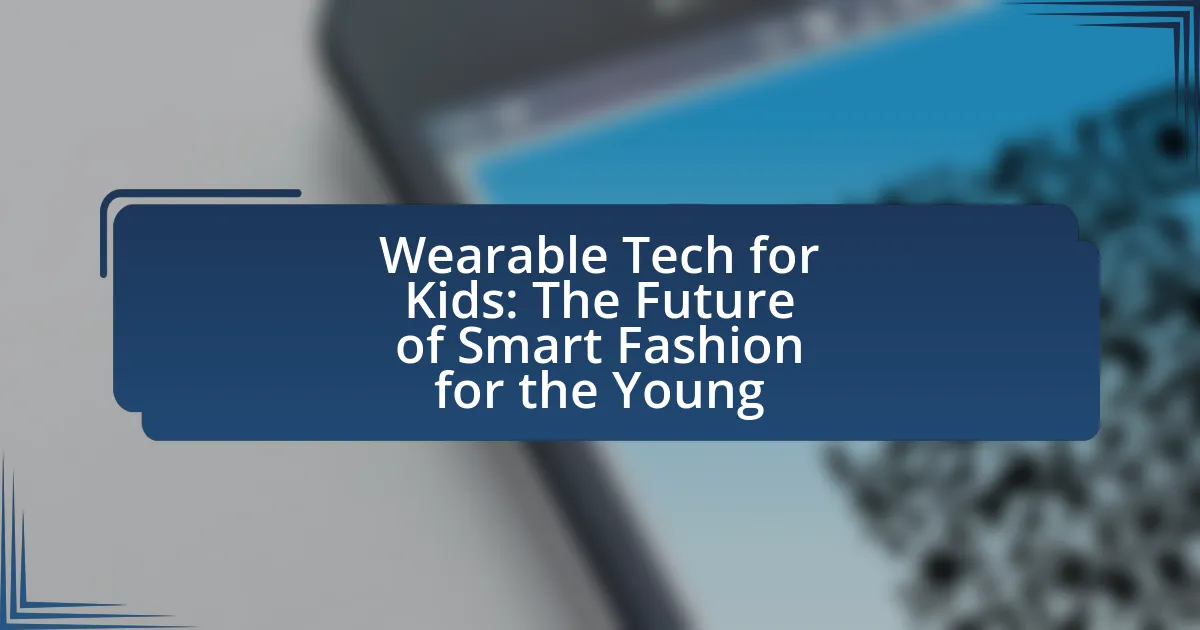Smart clothing is revolutionizing the retail experience by incorporating advanced technology that enhances customer engagement and personalization. This article explores how smart apparel, equipped with sensors and data collection capabilities, allows retailers to provide tailored recommendations and seamless transactions. Key features such as fitness tracking, augmented reality, and real-time feedback are discussed, along with the growing consumer interest in health monitoring and personalized experiences. Additionally, the article addresses the challenges retailers face in integrating smart clothing, including technology compatibility, consumer acceptance, and data privacy concerns, while highlighting best practices for effective marketing and customer education in this evolving market.

How is Smart Clothing Transforming the Retail Experience?
Smart clothing is transforming the retail experience by integrating technology that enhances customer engagement and personalization. This innovation allows retailers to offer tailored recommendations based on real-time data collected from the garments, such as body temperature and movement patterns. For instance, brands like Under Armour and Nike have developed smart apparel that tracks athletic performance, enabling customers to receive personalized feedback and suggestions for improvement. Additionally, smart clothing can facilitate seamless transactions through embedded payment systems, streamlining the purchasing process. According to a report by Allied Market Research, the global smart clothing market is projected to reach $4 billion by 2024, indicating significant growth and adoption in the retail sector.
What are the key features of smart clothing in retail?
The key features of smart clothing in retail include embedded technology, data collection capabilities, and enhanced customer interaction. Embedded technology allows garments to integrate sensors and connectivity, enabling functionalities such as tracking fitness metrics or monitoring body temperature. Data collection capabilities facilitate the gathering of user information, which can be analyzed to personalize shopping experiences and improve product recommendations. Enhanced customer interaction is achieved through features like augmented reality, which can provide virtual try-ons or interactive displays, thereby enriching the overall retail experience. These features collectively transform how consumers engage with clothing, making the shopping process more personalized and efficient.
How do sensors and technology enhance smart clothing?
Sensors and technology enhance smart clothing by enabling real-time data collection and analysis, which improves user experience and functionality. For instance, integrated sensors can monitor physiological metrics such as heart rate, temperature, and movement, allowing for personalized feedback and adjustments. This capability is supported by advancements in textile engineering and miniaturization of electronic components, which have made it feasible to embed these technologies seamlessly into fabrics. Research indicates that smart clothing can improve athletic performance and health monitoring, as evidenced by studies showing that wearables can provide insights that lead to better training outcomes and health management.
What role does data collection play in smart clothing?
Data collection is essential in smart clothing as it enables the monitoring of user metrics such as heart rate, body temperature, and activity levels. This data is processed to provide insights into health and fitness, enhancing user experience and personalization. For instance, a study by the Journal of Fashion Technology & Textile Engineering highlights that smart clothing can track physical performance, allowing users to optimize their workouts based on real-time feedback. This capability not only improves individual health outcomes but also informs retailers about consumer preferences and trends, ultimately transforming the retail experience.
Why is smart clothing gaining popularity among consumers?
Smart clothing is gaining popularity among consumers due to its ability to integrate technology into everyday apparel, enhancing functionality and user experience. This trend is driven by increasing consumer interest in health and fitness tracking, as smart clothing can monitor vital signs, activity levels, and even provide real-time feedback. According to a report by Grand View Research, the global smart clothing market is expected to reach $5.3 billion by 2025, reflecting a compound annual growth rate of 25.4%. This growth is fueled by advancements in textile technology and the rising demand for personalized and connected experiences in fashion.
What benefits do consumers seek from smart clothing?
Consumers seek several benefits from smart clothing, primarily including enhanced functionality, improved comfort, and health monitoring capabilities. Smart clothing integrates technology to provide features such as temperature regulation, moisture-wicking, and fitness tracking, which cater to the needs of active individuals. For instance, a study by the Consumer Technology Association found that 70% of consumers are interested in wearable technology that can track health metrics, indicating a strong demand for clothing that supports health and wellness. Additionally, smart clothing often offers convenience through connectivity with smartphones and other devices, allowing users to receive notifications and control settings seamlessly. These benefits collectively enhance the overall user experience, making smart clothing appealing to consumers.
How does smart clothing influence purchasing decisions?
Smart clothing influences purchasing decisions by enhancing consumer engagement and providing personalized experiences. The integration of technology in apparel allows consumers to track fitness metrics, receive real-time feedback, and access tailored recommendations, which increases their likelihood of making a purchase. For instance, a study by McKinsey & Company found that 60% of consumers are more inclined to buy products that offer interactive features, demonstrating that smart clothing can significantly impact buying behavior.
What challenges does the retail industry face with smart clothing?
The retail industry faces significant challenges with smart clothing, primarily related to technology integration, consumer acceptance, and data privacy. Technology integration poses difficulties as retailers must ensure that smart clothing is compatible with existing systems and infrastructure, which can require substantial investment and expertise. Consumer acceptance is another challenge, as many customers may be hesitant to adopt smart clothing due to concerns about usability, comfort, and the perceived value of the technology. Data privacy issues also arise, as smart clothing often collects personal data, leading to potential consumer distrust and regulatory compliance challenges. These factors collectively hinder the widespread adoption and success of smart clothing in the retail sector.
How do privacy concerns affect consumer acceptance of smart clothing?
Privacy concerns significantly hinder consumer acceptance of smart clothing. Many consumers fear that smart clothing, which often collects personal data, may lead to unauthorized data sharing or breaches. A survey conducted by the International Data Corporation found that 60% of consumers expressed concerns about how their data would be used and shared by manufacturers. This apprehension can result in reluctance to purchase smart clothing, as consumers prioritize their privacy over the potential benefits of technology.
What are the logistical challenges in integrating smart clothing into retail?
Integrating smart clothing into retail presents several logistical challenges, primarily related to supply chain management, inventory control, and technology integration. Supply chain management becomes complex due to the need for specialized materials and manufacturing processes that differ from traditional clothing, requiring retailers to establish new partnerships with tech manufacturers. Inventory control is also challenging, as smart clothing items often require precise tracking of both the garment and its embedded technology, complicating stock management and increasing the risk of overstock or stockouts. Additionally, technology integration poses hurdles, as retailers must ensure that smart clothing is compatible with existing systems for sales, customer data, and returns, which can lead to increased operational costs and training requirements for staff.
How does smart clothing impact customer engagement in retail?
Smart clothing enhances customer engagement in retail by providing personalized experiences and interactive features. Retailers utilizing smart clothing can collect data on customer preferences and behaviors, allowing for tailored marketing strategies and product recommendations. For instance, a study by the International Journal of Retail & Distribution Management found that 70% of consumers are more likely to engage with brands that offer personalized experiences. Additionally, smart clothing often includes technology that allows customers to interact with products in real-time, such as through augmented reality or mobile applications, further increasing engagement levels. This integration of technology not only attracts customers but also fosters brand loyalty, as consumers feel more connected to brands that understand their individual needs.
What innovations are emerging in smart clothing technology?
Innovations in smart clothing technology include the integration of sensors for health monitoring, temperature regulation, and connectivity features. These advancements allow garments to track vital signs such as heart rate and body temperature, providing real-time health data to users. For instance, companies like Under Armour and Nike have developed smart fabrics that can adjust to temperature changes, enhancing comfort during physical activities. Additionally, smart clothing can connect to mobile devices, enabling users to receive notifications and control other smart devices seamlessly. This technology is supported by research from the Massachusetts Institute of Technology, which highlights the potential of e-textiles in enhancing user experience and functionality in everyday wear.
What are the best practices for retailers adopting smart clothing?
Retailers adopting smart clothing should prioritize integrating technology seamlessly into their product offerings. This involves selecting high-quality materials that can support embedded technology without compromising comfort or style. Additionally, retailers must invest in educating their staff about the features and benefits of smart clothing to enhance customer engagement and support.
Furthermore, establishing partnerships with technology providers can facilitate access to the latest innovations and ensure compatibility with existing systems. Retailers should also focus on creating a user-friendly shopping experience, both online and in-store, by providing clear information about how smart clothing works and its advantages.
Data from the Global Smart Clothing Market Report indicates that the market is expected to grow significantly, highlighting the importance of early adoption and strategic positioning in this evolving sector. By following these best practices, retailers can effectively navigate the challenges of integrating smart clothing into their offerings and meet consumer demand.
How can retailers effectively market smart clothing to consumers?
Retailers can effectively market smart clothing to consumers by emphasizing the unique benefits and functionalities of the products, such as health monitoring and enhanced comfort. Highlighting features like integrated sensors that track fitness metrics or temperature regulation can attract health-conscious consumers. According to a report by Grand View Research, the global smart clothing market is expected to reach $5.4 billion by 2024, indicating a growing consumer interest in this category. Retailers should also utilize targeted digital marketing strategies, including social media campaigns and influencer partnerships, to reach tech-savvy audiences. Engaging storytelling that showcases real-life applications of smart clothing can further enhance consumer interest and drive sales.
What strategies can retailers use to educate customers about smart clothing?
Retailers can educate customers about smart clothing through interactive demonstrations and informative workshops. These strategies allow customers to experience the technology firsthand, enhancing understanding and engagement. For instance, retailers can set up in-store displays where customers can try on smart clothing and see its features in action, such as fitness tracking or temperature regulation. Workshops can provide detailed explanations of the technology behind smart clothing, including how it integrates with mobile devices and the benefits it offers. Research indicates that experiential learning significantly improves retention and comprehension, making these methods effective for customer education.





